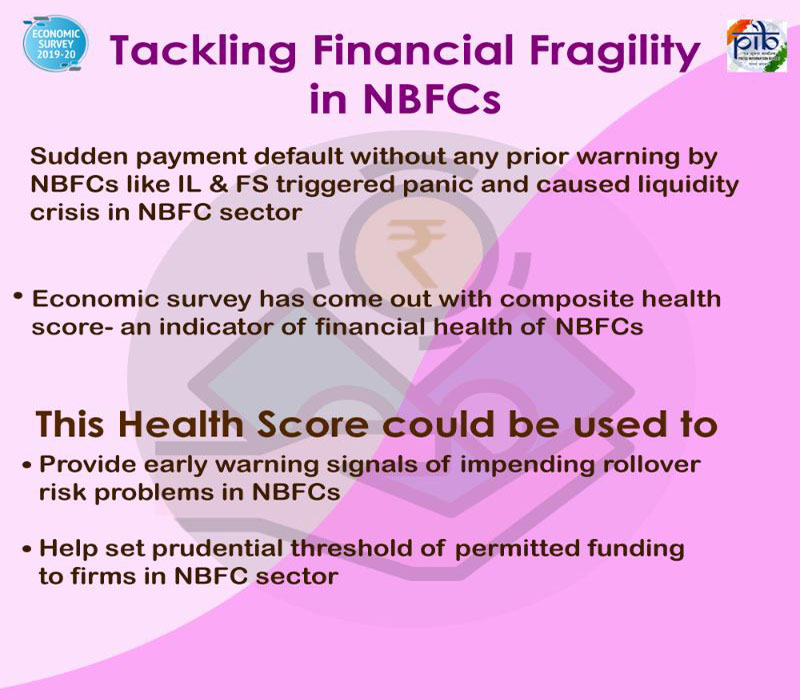A Novel Health Score Developed For NBFCS/HFCS Can Provide Early Warning Signals of Impending Liquidity Crisis in the Sector
Policy Makers Can Use the Health Score as a Monitoring Mechanism to Prevent Liquidity Crises

A new diagnostic Health Score developed for the Non-Banking Financial Company (NBFC) and Housing Finance Company (HFC) sectors can help detect early warning signals of impending liquidity problems facing the companies in this sector. Using a novel scoring methodology, quantifiable Rollover risk is calculated for the HFCs and the retail NBFCs. The Economic Survey 2019-20 presented by Union Minister for Finance and Corporate Affairs, Smt Nirmala Sitharaman in Parliament today gives a detailed analysis of this new methodology including its reliability in predicting financial health of NBFC and HFC firms. The Health Score can be used as a valuable tool to introduce corrective measures to address unfavourablefinancial trends in a timely manner, says the Pre-Budget survey.
Quoting the recent example of defaults on loan obligation by two subsidiaries of IL&FS and DHFL, the Economic Survey brings out the cascading adverse effect of NBFC defaults on the economy. The defaults by these two companies resulted in a chain reaction adversely affecting the market price of their Commercial Papers, panic sale by investors in debt mutual funds, steep decline in net asset value of these debt funds by 53% and a sharp decline in the equity prices of stressed NBFCs causing huge losses of Rs.4000 crores to NBFCs. This took a toll on the overall credit growth in the Indian Economy, and in turn, caused a decline in GDP growth.
HEALTH SCORE: Recent trends for NBFCs/HFCs
The Health Score is based on the Rollover risk which includes Asset Liquidity Management risk, interconnectedness risk and Financial and Operating Resilience of an NBFC.
The Economic Survey analysis shows that the Health Score for the HFC sector exhibited a declining trend post 2014. By the end of FY2019, the health of the overall sector had worsened considerably. Similarly, the Health Score of the Retail-NBFC sector was consistently below par for the period 2014 till 2019. Larger Retail-NBFCs had higher Health Scores but among medium and small Retail NBFCs, the medium size ones had a lower Health Score for the entire period from March 2014 till March 2019.
The above findings suggest that the Health Score provides an early warning signal of impending liquidity problems.The analysis also finds significant evidence that equity markets react favourably to increase in Health Score of individual HFCs and Retail-NBFCs, thereby confirming the validity of Health Score as an early warning signal.
Uses of Health Score:
The Pre-Budget Survey observes that this novel Health Score can be of immense use to policy makers with respect to the shadow banking channel of growth.
Health Score can serve the critical role of predicting refinancing related stress faced by the financial firms in advance. It can serve as an important monitoring mechanism to prevent such problems in future. Furthermore, disaggregating the components and examining their trends can shed light on how to regulate NBFCs.
Other than its utility as a leading indicator of stress in the NBFC sector, the Health Score can also be used by policy makers to allocate scarce capital to stressed NBFCs in an optimal way to alleviate a liquidity crisis.
As per the Survey, the Health Score can also be used to set prudential thresholds on the extent of wholesale funding that can be permitted for firms in the shadow banking system. Regulators can use the Health Score as a basis for optimally directing capital infusions to deserving NBFCs to ensure efficient allocation of scarce capital.
*****
RM/SC/NB/UD